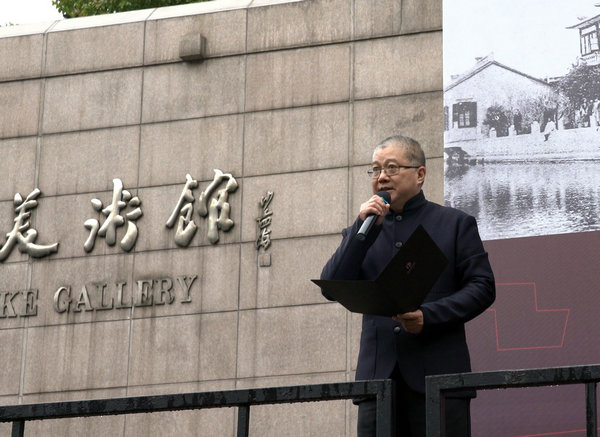 |
|
Xu Jiang, director of the China Academy of Art, speaks at the ceremony on Friday to mark the 90th anniversary of the academy's founding. [Photo/China Daily] |
With the publication and the exhibition, Xu aims to create a comprehensive academic system of Eastern aesthetic values - a work he compares to the Renaissance - to promote the country's cultural confidence.
Explaining his idea, he says its differs from so-called "Orientalism" in which Eastern cultures were judged from a Western perspective. "With a clear understanding of Chinese paintings and other visual art forms, we can better reflect our identity and speak for our own cultural consciousness in the world," he says.
"When we revitalize our traditions, it's not to simply copy old formats," Xu says. "We need to give it space and let its roots grow in modern society."
Separately, he says that media channels like animation and art design in films can showcase the Chinese aesthetics.
Despite his moves to promote Chinese aesthetic values, Xu says his aim is not to have an ethnocentric movement. Just as his predecessors did in 1928, Xu, who studied oil painting in Germany, seeks to include Western art.
For instance, the CAA's China Design Museum will open in April at the academy's Xiangshan Campus.
One of its opening exhibitions will feature items influenced by Bauhaus - the transient but globally influential German art school.
The Xianghsan event will be the first stop of a worldwide tour to mark the centennial of the birth of the Bauhaus school in 2019.
Another exhibition will feature Italian fashion design. And Portuguese architect Alvaro Siza, a Pritzker Award winner who designed the museum, will also have a solo exhibition at the museum.
"We have to embrace other cultures as well to form new ideas based on our own perspectives," Xu says.
When it comes to technology, Xu says the country needs to usher in a consciousness of cultural traditions into the field.
"My grandson is only 2," says Xu. "He can hardly understand this world. However, each time a mobile phone rings, he will immediately respond and tell his mother to answer it.
"This generation is heavily reliant on digital devices. It's our duty to develop new formats to help them not only accept traditional culture but to pass it on."
In a major development, the construction of a new CAA campus is set to begin in Liangzhu, a town in the west of Hangzhou, in April. Xu sees it as a way to connect the past with the future.
Liangzhu is a hub of an ancient culture dating back 5,000 years, whose relics are nominated as China's candidate for UNESCO World Heritage status in 2019. Liangzhu is close to Hangzhou's new development that focuses on scientific research.
Xu is planning another experiment. He aims to start a design school at the campus, where art students learn natural sciences for a semester.
"This is to combine science and fine art to encourage crossovers," he says.
"Liangzhu represents original Chinese culture. And with the help of the sciences we can create (original culture) now."
Contact the writer at wangkaihao@chinadaily.com.cn